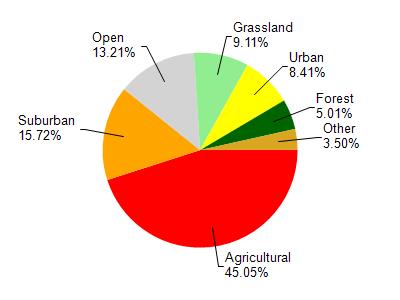Dane
No
No
No
Fish and Aquatic Life
Overview
Brandenburg Lake also known as Lake Katrine, is a 38-acre seepage lake with a mean depth of 6 ft and a maximum of 9 ft. The surrounding subwatershed is comprised of 60% agricultural lands, 14% grassland, 8% wetland and 4% residential. In the early 1980s, the lake was used for walleye rearing, but agricultural pesticides resulted in poor survival and that lake use was discontinued.
Date 2002
Author Aquatic Biologist
Historical Description
A shallow, land-locked seepage lake, Brandenburg Lake is located in a terminal moraine. The surrounding land is privately owned and is mostly agricultural. The shoreline is relatively undisturbed. The Girl Scouts have a permanent summer camp on the north shore and use the lake for swimming and boating. Waterfowl frequent the lake and hunting is allowed with permission of landowners. Public access to this lake is not available. The lake is used as a warm water game fish rearing pond by the Department of Natural Resources; fishing is not permitted. Severe winterkill conditions prohibit the establishment of a year-round fishery. Fish species: species being reared, usually walleye.
Source: 1985, Surface Water Resources of Dane County,WI: WI-DNR Brandenburg Lake (Lake Katrine) T8N, R8E, Sec. 6 Surface acres = 38, SDF = 1.15, Maximum depth = 6 ft.
Date 1985
Author Aquatic Biologist
Condition
Wisconsin has over 84,000 miles of streams, 15,000 lakes and milllions of acres of wetlands. Assessing the condition of this vast amount of water is challenging. The state's water monitoring program uses a media-based, cross-program approach to analyze water condition. An updated monitoring strategy (2015-2020) is now available. Compliance with Clean Water Act fishable, swimmable standards are located in the Executive Summary of Water Condition in 2018. See also the 'monitoring and projects' tab.
Reports
Recommendations
Lake Classification
Dane County Lake Classification-Phase 2: The Phase 1 classification grant classified all county lakes and streams. This grant will take the next step by developing a management program based on the classification.
Lake Classification
Dane County Department of Planning and Development will hire a project staff in order to develop a Lake Classification project, which is seen as the first step toward developing a consistent set of county-wide standards and procedures to protect Dane County Waters.
Management Goals
Wisconsin's Water Quality Standards provide qualitative and quantitative goals for waters that are protective of Fishable, Swimmable conditions [Learn more]. Waters that do not meet water quality standards are considered impaired and restoration actions are planned and carried out until the water is once again fishable and swimmable
Management goals can include creation or implementation of a Total Maximum Daily Load analysis, a Nine Key Element Plan, or other restoration work, education and outreach and more. If specific recommendations exist for this water, they will be displayed below online.
Monitoring
Monitoring the condition of a river, stream, or lake includes gathering physical, chemical, biological, and habitat data. Comprehensive studies often gather all these parameters in great detail, while lighter assessment events will involve sampling physical, chemical and biological data such as macroinvertebrates. Aquatic macroinvertebrates and fish communities integrate watershed or catchment condition, providing great insight into overall ecosystem health. Chemical and habitat parameters tell researchers more about human induced problems including contaminated runoff, point source dischargers, or habitat issues that foster or limit the potential of aquatic communities to thrive in a given area. Wisconsin's Water Monitoring Strategy was recenty updated.
Grants and Management Projects
Monitoring Projects
| WBIC | Official Waterbody Name | Station ID | Station Name | Earliest Fieldwork Date | Latest Fieldwork Date | View Station | View Data |
|---|
| 774700 | Brandenburg Lake | 10001222 | Brandenburg Lake | 7/27/1999 | 9/22/2017 | Map | Data |
| 774700 | Brandenburg Lake | 134002 | Brandenburg Lake - Brandenburg Lake | 8/27/1979 | 5/14/2010 | Map | Data |
|

Watershed Characteristics
Brandenburg Lake is located in the Six Mile and Pheasant Branch Creeks watershed which is 119.45 mi². Land use in the watershed is primarily agricultural (45%), suburban (15.70%) and a mix of open (13.20%) and other uses (26.00%). This watershed has 145.61 stream miles, 9,959.08 lake acres and 2,759.80 wetland acres.
Nonpoint Source Characteristics
This watershed is ranked Not Available for runoff impacts on streams, Not Available for runoff impacts on lakes and High for runoff impacts on groundwater and therefore has an overall rank of High. This value can be used in ranking the watershed or individual waterbodies for grant funding under state and county programs.However, all waters are affected by diffuse pollutant sources regardless of initial water quality. Applications for specific runoff projects under state or county grant programs may be pursued. For more information, go to surface water program grants.